| |

US Environmental
Protection Agency
 CLICK here for a special web-page linking to the new EPA
CLICK here for a special web-page linking to the new EPA
Numerical Nutrient Standards
as developed for Florida

SLIDES:
(Note that terms NNC and NNS interchangeably used designate the same thing : Criteria = Standards!)
 Timeline of NNS development and its implementation
Timeline of NNS development and its implementation
 Lake classification
Lake classification
 Developing the Numerical Nurient Standards for lakes
Developing the Numerical Nurient Standards for lakes
 Standards for lakes
Standards for lakes
 Standards for lakes according to their color and alkalinity
Standards for lakes according to their color and alkalinity
 Criteria for streams - reference based approach
Criteria for streams - reference based approach
 Downstream Protection Values
Downstream Protection Values
 Criteria for streams and Site-Specific Alternative Criteria
Criteria for streams and Site-Specific Alternative Criteria
 Water Quality Assessment and Existing TMDL
Water Quality Assessment and Existing TMDL
 Implementation and Economic Analysis
Implementation and Economic Analysis
 NNC controversies
NNC controversies
 Example of Lake Okeechobee
Example of Lake Okeechobee
|
| |
 |
EPA - NNC for Florida |
|
|
| |
| |
Selected Slide Shows (Mouse-over slide pictures for full
size)
|
Numerical Nutrient Standards
EXPLAINED
|
|
Dr. G.M. Naja, The Everglades Foundation
(Mouse-over slide thumbnails for enlargement pop-up)
|
|
 |
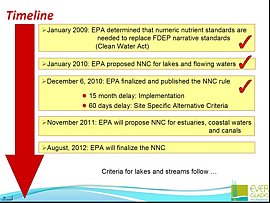 |
TIMELINE of NNS development and its implementation |
| The nutrient criteria were the result of a lawsuit against the EPA filed by the environmental law firm Earthjustice, alleging that the lack of nutrient standards governing Florida waterways was in violation of the Clean Water Act. Earthjustice represented several state environmental agencies in the case, including the Florida Wildlife Federation, the Sierra Club, the Conservancy of Southwest Florida and the St. Johns Riverkeeper.
In 2009, the EPA determined that numerical standards for nutrient levels in Florida waters will replace the narrative standards as practised by the FDEP. The new NNS rules were first proposed in January 2010. Following extensive discussions and subsequent delineation of these standards, they would come into effect in early 2012. Additional set of Numerical Nutrient Standards for estuaries, coastal waters and canals will be forthcoming in November 2011. |
|
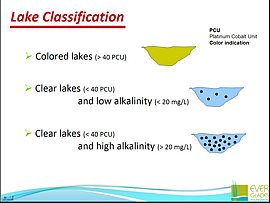 |
Lake classification |
Lakes that are polluted support undesirable and excessive growth - particularly of algae. They contain growth-related organic substance Chlorophyl which is conveniently being used as an indicator of the lake pollution level.
Water color is measured in the PCU units (Platinum Cobalt Units).
orrespondingly, the lakes are divided into:
-
"colored" lakes (>40 PCU),
- "colored lakes with low alkalinity" (<20 mg.L)
- "colored lakes with high alkalinity" (>20 mg/L)
(Mouse-over slide thumbnails for enlargement pop-up)
|
|
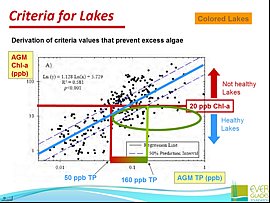 |
Developing the Numerical Nurient Standards for lakes |
Polluted lakes, rich in nutrient elements (mainly nitrogen and phosphorus), support the growth of undesirable algae. The degree of lake pollution by excessive nutrients is indicated by elevated levels of Chlorophyl-a. The EPA sampled all the lakes in Florida, analyzing for Chlorophyl-a and Total Phosphorus. When plotted, the these values show a definite correlation with a trend.
Lakes that are considered NOT healthy have concentrations of Chl-a in excess of 20 ppb. For them the maximum allowable TP levels are to be below 50ppbTP. However, it has been noted that lakes could be healthy even with TP levels exceeding 50 ppbTP. For this type of lakes, the new standards allow not a single TP maximum but a range between (50-160) ppbTP.
(Mouse-over slide thumbnails for enlargement pop-up) |
|
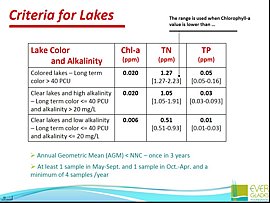 |
Standards for lakes |
Based on the above Chl-a correlation with TP, the maximum numerical values have been determined for Total Nitrogen (TN) and Total Phosphorus (TP) for different types of lakes as classified:
- Colored lakes (long-term color > 40 PCU)
- Clear lakes with high alkalinity
- Clear lakes with high alkalinity
Note the standards in the slide table.
(Mouse-over slide thumbnails for enlargement pop-up) | |
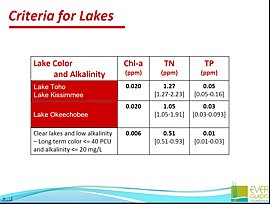 |
Standards for lakes according to their color and alkalinity |
Examples of lake could be quoted such as:
Lake Toho and Lake Kissimmee -
Lake Okeechobee
-
Clear lakes would have low long-term color (<= 40 PCU) and alkalinity (<= 20 mg/L) .
(Mouse-over slide thumbnails for enlargement pop-up)
|
|
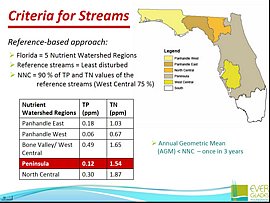
|
Criteria for streams - reference based approach |
The EPA used the reference based approach to develop the stream criteria. The USEPA divided Florida into 5 nutrient watershed regions, namely: Panhandle West, Panhandle East, West Central. North Central and Peninsula. In each of these nutrient watersheds, they selected the least disturbed stream as the reference streams and it was decided to set the nutrient criteria at the 90th percentile of the TP and TN level of theses reference streams. Because of the lack of reference streams in the West Central region, the benchmark in this nutrient watershed region was set at the 75th percentile.
The Table summarizes the TN and TP nutrient criteria to not be exceeded more than once in 3 years.
. |
|
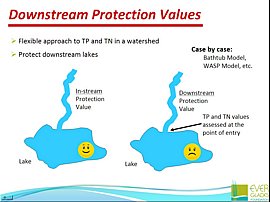
|
Downstream Protection Values (DPVs) |
An important provision in these Standards is the Downstream Protection Value whereby this provision is set to protect downstream sensitive lakes.
A stream flowing into a healthy lake should meet the in-stream protection values (as presented in the preceding Table for streams).
If the lake in not healthy, the stream flowing into the lake should meet downstream protection values developed case by case using some specific modeling tools. Examples of the latter are the "Bathtub" and "WASP" models used by the SFWMD.
(Mouse-over slide thumbnails for enlargement pop-up)
|
|
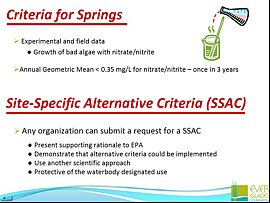 |
Criteria for streams and Site-Specific Alternative Criteria |
The criteria for springs are developed from experimental and field data while checking the response of bad algae in correlation with nitrate/nitrite concentrations. From these studies, the EPA set up the values at 0.35 mg/L as the criteria for nitrate/nitrite for springs.
Another provision is the Site Specific Alternative Criteria (SSAC) whereby any organization can submit a SSAC for any waterbody or a watershed. They need to present a supporting rationale to the EPA demonstrating that alternative criteria could be implemented while using an alternative scientific approach protective of the designated use of the waterbody.
(Mouse-over slide thumbnails for enlargement pop-up)
|
|
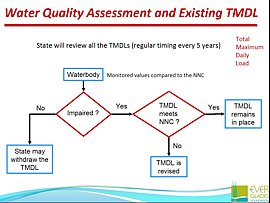 |
Water Quality Assessment and Existing TMDL |
The State has a duty to monitor and maintain the water quality in lakes, rivers and canals. Examination and testing of water quality is to take place at least once in 5 years.
What will happen with the existing TMDLs ?
The state will be reviewing all the TMDLs (regular procedure, once every 5 years). For each waterbody, the state will need to check if the monitored values are meeting the Numeric Nutrient Standards. While comparing these two values, they will examine if the waterbody is impaired. In the case that the waterbody is NOT impaired, the state may withdraw the TMDL. In the opposite case, the FDEP will check if the TMDL is meeting the NNS. If YES, the TMDL would remain in place, if NOT, the TMDL would be revised.
|
|
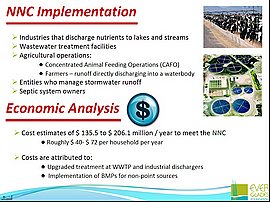 |
Implementation and Economic Analysis |
The major targets of the new NNSs will be wastewater treatment plants of industries and urban areas that would discharge into lakes and streams, agricultural operations, entities managing stormwater and septic system owners.
Economic analysis carried out by the EPA indicates that the cost will be nowhere as exorbitant as sometimes quoted. They are estimated to be approximately $135-205 million per year, roughly $40-72 per household.
(Mouse-over slide thumbnails for enlargement pop-up)
| |
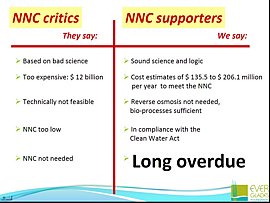 |
NNC controversies |
Everglades restoration calls for maintaining the Florida surface waters - and aquifers - clean and ecologically in a good and healthy state. All major watersheds of the Everglades require attention in order to meet this objective.
With a century of human interference with Florida surface waters and its canalization as well as exploding human population in the state, decades of delay in repairing the water quality decay already caused extensive damage to the ecosystem, endangering also the fresh water supply to the entire peninsula of Florida.
Application of the Clean Water Act in the state is long overdue.
(Mouse-over slide thumbnails for enlargement pop-up)
|
|
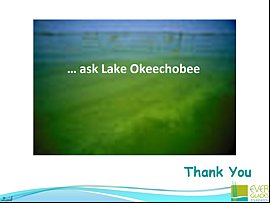
|
Example of Lake Okeechobee |
|
EvergladesHUB.com thanks Dr. Naja for making this brief and educational
presentation available for all to view on the web.
|
USEPA-NNS brief - courtesy of the EF

|
|
|
|
| |
|
| |
|
|
<<
Return to the TOP of Page |
|
|
|

![]() CLICK here for a special web-page linking to the new EPA
CLICK here for a special web-page linking to the new EPA 















